Importante ejemplo en el humor de equilibrio entre contenido y forma
A Boligán, laureado humorista gráfico a nivel internacional, lo conocí junto a Ares, Abela y otros, a finales de los años 80 en las Bienales organizadas por el Museo del Humor de San Antonio de los Baños en La Habana. Y también en otras presentaciones de mi grupo La Seña del Humor de Matanzas. Recuerdo que Boligán Nos hizo una caricatura grupal, obra que fue distinguida en una de las Bienales. Por suerte nunca hemos perdido el contacto. Hasta hemos coincidido en eventos internacionales. Además, siempre ha estado dispuesto a asesorarme cuando incursioné por primera vez en el humor gráfico, cosa que le agradezco mucho.
Y por si fuera poco, he tenido el honor y el placer de publicar un libro con él: "Historias de bufones", cuyo lanzamiento lo organizó el Instituto Quevedo de las Artes del Humor, en España.
Dudo que alguien que esté dentro o en los alrededores del universo del humor gráfico no conozca a Boligán. Su carrera como humorista gráfico es reconocida a nivel mundial. En resumen, me considero su amigo, soy admirador de su obra y es un placer tenerlo aquí “dialocando” conmigo.
PP: ¿Cómo ha sido la evolución de tu obra desde tus inicios hasta ahora? Haz un breve recorrido por todas tus etapas como creador de humor.
BOLIGÁN: Creo que no muy diferente a la de otros autores del género, salvo algunos detalles que trataré de resumirte:
Soy un artista gráfico en función del periodismo. Me formé desde las Artes Plásticas, por lo que en mi obra la forma siempre juega un papel importante, acompañando el mensaje con la sutileza, elegancia o fuerza que el tema requiera. En este aspecto, y consciente que una caricatura es buena cuando tiene un buen equilibrio de contenido y forma, después de largos años de trabajo cuando logre con frecuencia esto, se pueda hablar de evolución.
Te cuento brevemente las que considero son mis etapas como creador:
Era 1979 en mi pueblo natal, San Antonio de los Baños, Cuba, cuando se inauguró el Museo Internacional del Humor, el cual reunió la obra original de la historia del humor gráfico cubano y a la par se convocó, a manera de concurso, la 1ra Bienal Internacional del Humor (evento que aún se celebra). Entonces era un adolescente de unos 13 años que había vivido una infancia feliz y agreste, donde el dibujo, como todo niño, estuvo presente en la mesa del comedor en mis ratos de ocio casero, fuera de horario de comida o cuando llovía. Esta Bienal fue mi primer contacto visual directo con la caricatura y sus autores; además, supe en ese momento que en mi pueblo habían nacido varios de los más importantes caricaturistas de la isla, de ahí el haber sido escogido para este Museo y Bienal. Desde entonces es conocido como San Antonio de los Baños, “La villa del humor”.
Para 1980 ya estaba vinculado al Museo del Humor como joven aficionado. En 1981 en la 2da Bienal ya participé en el mural colectivo junto a varios consagrados autores, dando la primera pincelada como el caricaturista más joven. Puedo definir esta como mi primera etapa de descubrimiento e introducción en este mundo de trazos y humor.
En 1983 comencé a publicar en la prensa regional y nacional cubana. En 1987 me titulé como Profesor Instructor de Artes Plásticas, y también comencé a obtener algunos reconocimientos nacionales e internacionales. Fueron años muy activos que, junto a otros jóvenes caricaturistas, tuvimos una época de aprendizaje, experimentación y participación en cada festival, concurso, exposición y evento que nos fuera posible, por lo que nos consideran como la generación de los 80. Esta es la segunda etapa de mi aprendizaje.
En 1992 viajé a la Ciudad de México a realizar una exposición en el Museo de la Caricatura, y de inmediato tuve la invitación a colaborar en varios medios mexicanos, entre ellos el diario nacional El Universal, con el que desde entonces colaboro y en el que he tenido las mayores oportunidades de crecimiento como artista, al tener importantes espacios como ilustrador y como cartonista de opinión durante tantos años. Traer una formación plástica desde Cuba y acoplarla al ritmo y rigor del diario me llevó durante la década de los 90 a otra etapa de aprendizaje y crecimiento al lado de grandes caricaturistas mexicanos; esta es mi tercera etapa.
A partir del 2000 y en especial el 2006 hasta hoy, y gracias también a las redes sociales, mi obra ha tenido una mayor presencia tanto en México como a nivel internacional. Trabajo sobre temas y noticias del momento, pero también sobre los temas y mensajes que más me interesan como autor. Me considero un cronista gráfico de la época que nos ha tocado vivir; aún estoy en esta etapa.
PP: Tu curriculum habla por ti. Sin dudas, pasas a la historia del humor gráfico cubano. Y ahora, sin modestia ni falsa modestia, dime con franqueza; ¿sientes que has logrado un nivel altísimo en tu carrera y que por lo tanto es justo que hayas pasado a la historia?
BOLIGÁN: Amigo mío, yo te agradezco mucho ese criterio sobre mi trabajo, creo que esa isla ha dado grandes artistas del ramo y seguramente muchos aparecemos en tu “Diccionario del humor”, otros los albergará el museo de mi pueblo, pero siempre serán los conocedores los que nos juzguen, califiquen y den nuestro lugar, no se debe ser juez y parte.
PP: Te especifiqué que era sin modestia. Era un simple ejercicio. Por ejemplo, yo puedo decir que soy buen humorista, uno no debe presumir ni ser soberbio, pero es obvio que uno sabe si o es es o no. En tu caso, solo por tu curriculum es obvio que lo sabes. Lo feo sería ponerse a comparar tus logros con los de otros. Pero bueno, tienes la libertad de responder o no y sabes que no pasa nada. Así que voy a otro tema. Mira, tú te has especializado en viñetas editoriales y en humor general. ¿Cuál te es más difícil de hacer? ¿Con cuál de ellos disfrutas más en tu creación? ¿Cuáles son las diferencias entre ambas?
BOLIGÁN: El vivir y trabajar en México me dio un ritmo muy alto de trabajo y seguimiento de las noticias, este es un país con una gran tradición y respeto por el humor político.
Disfruto dibujar sobre un hecho, una noticia, y trato de descubrirla y plantearla desde otro ángulo, otro punto de vista que no sea precisamente al que nos quieren llevar la nota.
Pero creo que disfruto más proponiendo mi propio tema, encontrando en el andar, a mi alrededor, en lo cotidiano, en el comportamiento humano, en la vida misma los absurdos cotidianos que nos rodean y que no precisamente tenga que coincidir con las noticias del día.
Me gusta fusionar temas duros de opinión con humor o viceversa, hacer humor sobre temas aparentemente blandos, pero que rascándoles un poquito debajo, siempre encuentras una intención, una reflexión.
El humor de opinión lleva implícito eso, tu opinión sobre un tema por lo general de política, economía, etc., el humor general, o blanco, o gag, no precisamente tiene que opinar sobre algo, es el juego del chiste ingenioso, fresco y una situación jocosa que siempre busca provocar la risa.
PP: Sin dudas, disfrutas más el humor de opinión, como le llamas, pero también te he visto incursionar en el humor blanco y lo haces muy bien también. Pero lancémonos a dialocar sobre algo más teórico. Por ejemplo, ¿cuál es tu opinión sobre las diferencias en el humor gráfico? ¿El humor gráfico es un “paraguas” que cubre la caricatura, la caricatura personal, la tira cómica, la historieta cómica, la viñeta editorial, etc., o corren por carriles distintos todos esos conceptos?
BOLIGÁN: Este tema está un poco “rega'o”. Suele pasar que en cada país le llaman o interpretan de diferentes maneras, por ejemplo: desde Cuba siempre me presenté como caricaturista y ahí entraba todo, pero realmente caricaturista es quien hace caricaturas personales (al presentarte, enseguida alguien te pone a trabajar pidiendo le hagas una caricatura), tal vez sería más adecuado presentarme solo como humorista gráfico, para que ahí quepa la caricatura, los dibujos de opinión y humor blanco que también hago, ¿pero y las historietas y tiras cómicas y las viñetas e ilustraciones? En México también se entiende caricaturista como nombre genérico a los que hacemos humor gráfico, pero en la prensa maneja el término “Cartones”, para nuestras secciones de dibujos de opinión; o sea, somos Cartonistas, pero para colmo se nos conoce también y muchos se definen con el término “Moneros”, pues hacer “monitos” que es hacer muñequitos… realmente soy todo esto: caricaturista, humorista gráfico de opinión y humor, historietista, viñetista, ilustrador, cartonista y monero.
Tal vez deberíamos ponernos de acuerdo y escoger una sola palabra que defina o sirva de paraguas y donde debajo quepa todo eso, pero podríamos perder todas estas gamas y colores que al final son lo mismo y es humor.
PP: Por eso hago este tipo de preguntas, porque me interesa mucho el tema. En mi libro “La Metahumorfosis” sugiero que el “paraguas” sea “humor gráfico”; pero en fin, sabemos que no es fácil ponerse de acuerdo, entre otras cosas porque muchos piensan que no vale la pena perder el tiempo en la teoría. Yo creo que sí lo vale, por eso me alegra que a ti también te interese, aún cuando no te importe que te clasifiquen como quieran. Teorizar sobre el humor es así, muy complicado. Y en este punto te confieso que me es imposible no preguntarte: ¿cuáles son los límites del humor, si los tuviera?
BOLIGÁN: Lamentablemente hay muchos límites impuestos por nosotros mismos, los gobiernos, las ideologías, las religiones, los fanáticos, lo políticamente correcto, los brutos con poder que no tienen humor, etc., etc.. Pero ese es el reto del buen humorista: llegar lo más lejos posible.
Hay una línea imaginaria (la raya) que se supone no debemos pasar, y he ahí el reto, llevar esa línea lo más lejos posible. No nos detienen las leyes, ni la censura, ni la violencia, ni las balas, solo podemos lograrlo con el buen humor, sin caer en lo burdo y chabacano; provocando y criticando con inteligencia, pero respetando a la vez, y claro, empujando la raya un poco más allá cada vez que cierren los ojos para reír.
PP: Eso último sonó casi a consejo (coincido contigo en el planteamiento), por ello me provoca ahora preguntarte: ¿qué le aconsejarías a esos jóvenes creadores que te ven como gran referente? ¿Qué le dirías a los colegas consagrados que te admiran? ¿Y a los colegas consagrados que te envidian? ¿Qué le dirías al público que te sigue? ¿Y al público que en general le interesa el humor gráfico? ¿Y qué le dirías al público que no consume esta modalidad? Y también, ¿qué le aconsejarías a Boligán? ¿Y qué me aconsejarías a mí? (Para que no quede nadie sin tu consejo).
BOLIGÁN: Y te respondo…
* A los jóvenes les aconsejo la perseverancia, la tenacidad y buscar la mayor cantidad de buenas referencias de colegas de todas partes del mundo. Al final somos una esponja, nuestros estilos no son más que la fusión de lo mejor que hemos aprendido de nuestros mejores referentes.
* A los colegas consagrados que me admiran les agradezco, es un acto de nobleza y humildad que no todos logran sentir y reconocer, también admiro a muchos colegas consagrados y no consagrados.
* A los colegas consagrados que me envidian también les agradezco, eso significa que estoy haciendo las cosas bien o que tengo éxito; de lo contrario no la sentirían. Si la envidia es benigna, no es grave; si es maligna e incontrolable, a punto del ridículo y la obsesión, habla mucho más de la calidad de lo que hacemos, pero no deben olvidar aquella frase que dice: “GRANDE ES AQUEL QUE PARA BRILLAR, NO NECESITA APAGAR LA LUZ DE LOS DEMÁS”.
* Al público que me sigue igual les agradezco y mucho, me comprometen a trabajar duro al saber que hay muchos ojos esperando.
* Gracias también al público interesado en el humor gráfico, la caricatura, historietas, ilustraciones, cartones o monitos, ¡esperamos no decepcionarlos!
* A los que no consumen el humor, me preocupan; el humor es salud y se puede consumir con exceso y sin medida, no engorda, solo puede producir patas de gallina al lado de los ojos.
* A mí me aconsejo seguir haciendo y consumiendo humor a diario.
* A Pelayo le aconsejo lo mismo que a mí al derecho y al revés, al menos 3 veces al día. Somos muchos ojos esperando su “Seña de humor” y nuestras patas de gallina.
PP: Sigo tu consejo al pie de la letra, amigo mío. Y para ir cerrando: ¿qué te gustaría hacer o lograr dentro del humor que no hayas hecho o logrado aún?
BOLIGÁN: Creo que siempre falta mucho por hacer, solo el andar te lleva a encrucijadas y nuevos caminos que explorar y conquistar, sólo quiero seguir andando y asumir los retos de los nuevos caminos, si es que llegan.
PP: Todo eso lo lograrás, sin dudas. Pero yo me refería a que si te gustará hacer otra cosa como escribir, actuar, etc., pero sé que eres feliz con lo que haces y no necesitas nada más, ¿no es cierto? Bueno, cerraré este diáloco como siempre lo hago: ¿se te ocurre una pregunta que deseaste te hubiera hecho? Y si es así, ¿puedes responderla?
BOLIGÁN: La verdad no se me ocurre ninguna, creo que hablamos bastante y podemos aburrir a los lectores, mejor aprovecho y te agradezco por la entrevista, por tu talento y constancia como promotor del humor en todas sus ramas, pero principalmente ¡agradezco tu amistad y confianza!
PP: El agradecido soy, amigo mío. Espero que sigas obteniendo premios; espero como siempre, seguir disfrutando tus obras por Internet, espero que nos siga yendo bien con nuestro libro y espero que coincidamos de nuevo en eventos por esos mundos. Disculpa por robarme un poco tu tiempo, pero los lectores van a estar felices de acercarse más a ti, de conocer un poco más al artista que está detrás de tantas obras que prestigian al humor. Un abrazo.
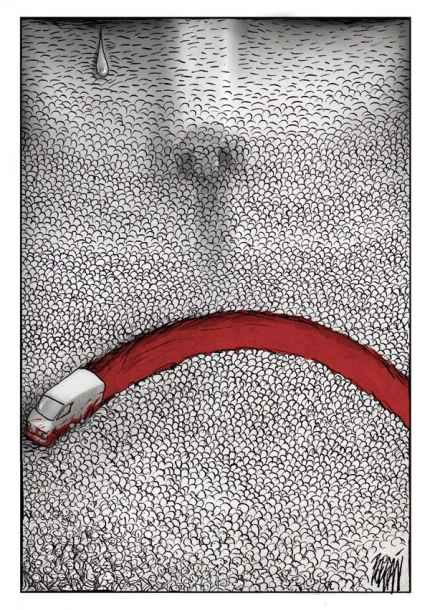
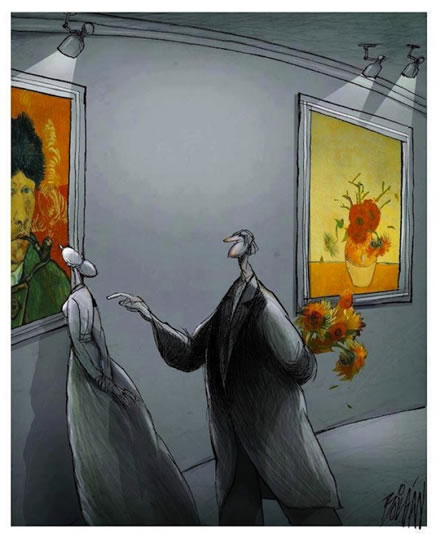
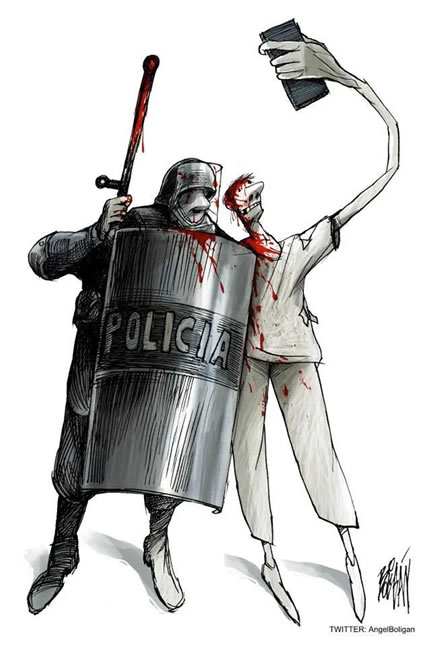
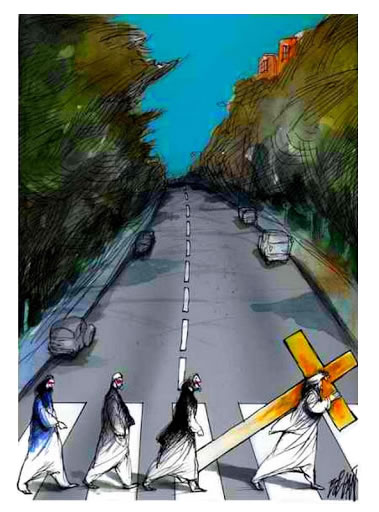
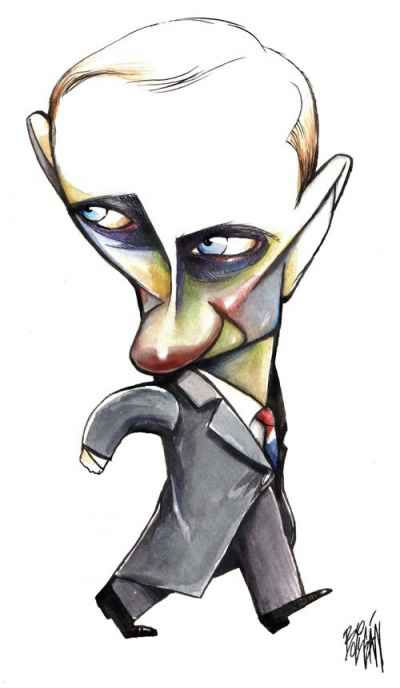
Interview with Ángel Boligán
By Pepe Pelayo
Important example in humor of balance between content and form
I met Boligán, a laureate international cartoonist, along with Ares, Abela and others, at the end of the 80s at the Biennials organized by the San Antonio de los Baños Museum of Humor in Havana. And also in other presentations of my group La Seña del Humor de Matanzas. I remember that Boligán made a group caricature for us, a work that was honored in one of the Biennials. Luckily we have never lost contact. We have even met at international events. Furthermore, he has always been willing to advise me when I first ventured into graphic humor, for which I am very grateful.
And if that were not enough, I have had the honor and pleasure of publishing a book with him: "Historias de bufones", whose launch was organized by the Quevedo Institute of the Arts of Humor, in Spain.
I doubt that anyone who is in or around the universe of graphic humor does not know Boligan. His career as a graphic comedian is recognized worldwide. In short, I consider myself your friend, I am an admirer of your work and it is a pleasure to have you here “dialocating” with me.
PP: How has the evolution of your work been from your beginnings until now? Take a brief tour of all your stages as a humor creator.
BOLIGÁN: I think not very different from that of other authors of the genre, except for some details that I will try to summarize for you:
I am a graphic artist based on journalism. I trained in the Plastic Arts, so in my work form always plays an important role, accompanying the message with the subtlety, elegance or strength that the subject requires. In this aspect, and aware that a cartoon is good when it has a good balance of content and form, after long years of work when it frequently achieves this, one can speak of evolution.
I will briefly tell you what I consider to be my stages as a creator:
It was 1979 in my hometown, San Antonio de los Baños, Cuba, when the International Museum of Humor was inaugurated, which brought together the original work in the history of Cuban graphic humor and at the same time, as a contest, the 1st International Biennial of Humor (event that is still celebrated). Then I was a teenager of about 13 years old who had lived a happy and wild childhood, where drawing, like every child, was present on the dining room table during my leisure time at home, outside of mealtimes or when it was raining. This Biennial was my first direct visual contact with the caricature and its authors; Furthermore, I knew at that moment that several of the most important caricaturists on the island had been born in my town, hence having been chosen for this Museum and Biennial. Since then it has been known as San Antonio de los Baños, “The town of humor.”
By 1980 he was already linked to the Museum of Humor as a young fan. In 1981 at the 2nd Biennial I already participated in the collective mural along with several established authors, giving my first brush as the youngest caricaturist. I can define this as my first stage of discovery and introduction into this world of strokes and humor.
In 1983 I began to publish in the regional and national Cuban press. In 1987 I qualified as a Professor Instructor of Plastic Arts, and I also began to obtain some national and international recognitions. They were very active years in which, together with other young cartoonists, we had a time of learning, experimenting and participating in every festival, contest, exhibition and event that was possible, which is why we are considered the generation of the 80s. This is the second stage of my learning.
In 1992 I traveled to Mexico City to hold an exhibition at the Museum of Caricature, and I was immediately invited to collaborate in several Mexican media, including the national newspaper El Universal, with which I have collaborated since then and in which I have had the greatest opportunities for growth as an artist, having had important spaces as an illustrator and as an opinion cartoonist for so many years. Bringing plastic training from Cuba and coupling it to the rhythm and rigor of the newspaper took me during the 90s to another stage of learning and growth alongside great Mexican cartoonists; This is my third stage.
From 2000 and especially 2006 until today, and also thanks to social networks, my work has had a greater presence both in Mexico and internationally. I work on topics and news of the moment, but also on the topics and messages that interest me most as an author. I consider myself a graphic chronicler of the times in which we live; I'm still at this stage.
PP: Your resume speaks for you. Without a doubt, you go down in the history of Cuban graphic humor. And now, without modesty or false modesty, tell me frankly; Do you feel that you have achieved a very high level in your career and that therefore it is fair that you have gone down in history?
BOLIGÁN: My friend, I thank you very much for that opinion about my work, I believe that that island has produced great artists in the field and surely many of us appear in your “Dictionary of Humor”, others will be housed in the museum of my town, but they will always be the knowledgeable ones who judge us, qualify us and give our place, one should not be judge and party.
PP: I specified to you that it was immodest. It was a simple exercise. For example, I can say that I am a good comedian, one should not boast or be arrogant, but it is obvious that one knows whether one is one or not. In your case, just from your resume it is obvious that you know. The ugly thing would be to compare your achievements with those of others. But hey, you have the freedom to respond or not and you know that nothing happens. So I'm going to another topic. Look, you have specialized in editorial cartoons and general humor. Which one is more difficult for you to do? Which of them do you enjoy most in your creation? What are the differences between both?
BOLIGÁN: Living and working in Mexico gave me a very high pace of work and following the news; this is a country with a great tradition and respect for political humor.
I enjoy drawing about a fact, a piece of news, and I try to discover it and present it from another angle, another point of view that is not precisely the one they want to take us to in the note.
But I think I enjoy more proposing my own topic, finding in my walk, around me, in everyday life, in human behavior, in life itself the daily absurdities that surround us and that do not exactly have to coincide with the news of the day. .
I like to merge hard topics of opinion with humor or vice versa, make humor about apparently soft topics, but by scratching them a little underneath, you always find an intention, a reflection.
Opinion humor implies that, your opinion on a topic, usually politics, economics, etc., general humor, or white humor, or gag, does not exactly have to give an opinion on something, it is the game of witty, fresh jokes. and a humorous situation that always seeks to provoke laughter.
PP: Without a doubt, you enjoy opinion humor more, as you call it, but I have also seen you dabble in white humor and you do it very well too. But let's start talking about something more theoretical. For example, what is your opinion on the differences in graphic humor? Is graphic humor an “umbrella” that covers the caricature, the personal caricature, the comic strip, the comic strip, the editorial cartoon, etc., or do all of these concepts run along different tracks?
BOLIGÁN: This topic is a bit “rega'o”. It usually happens that in each country they call it or interpret it in different ways, for example: from Cuba I always introduced myself as a caricaturist and that was where everything came in, but a caricaturist is really someone who makes personal caricatures (when you introduce yourself, someone immediately puts you to work asking you to do a caricature), perhaps it would be more appropriate to present myself only as a graphic humorist, so that the caricature, the opinion drawings and white humor that I also make fit in, but what about the comics and comic strips and the vignettes and illustrations? In Mexico, caricaturist is also understood as a generic name for those of us who create graphic humor, but in the press the term “Cartons” is used for our opinion drawing sections; In other words, we are Cartonistas, but to make matters worse we are also known and many define themselves with the term “Moneros”, because making “monitos” which is making little dolls… I really am all of this: caricaturist, graphic humorist of opinion and humor, cartoonist, vignette artist, illustrator, cartoonist and monero.
Maybe we should agree and choose a single word that defines or serves as an umbrella and where all that fits underneath, but we could lose all these ranges and colors that in the end are the same and it is humor.
PP: That's why I ask these types of questions, because I'm very interested in the topic. In my book “The Metahumorphosis” I suggest that the “umbrella” is “graphic humor”; But anyway, we know that it is not easy to agree, among other things because many think that it is not worth wasting time on theory. I think it is worth it, that's why I'm glad that you're also interested, even if you don't mind being classified however they want. Theorizing about humor is like that, very complicated. And at this point I confess that it is impossible for me not to ask you: what are the limits of humor, if it had any?
BOLIGÁN: Unfortunately there are many limits imposed by ourselves, the governments, the ideologies, the religions, the fanatics, the politically correct, the brutes with power who have no humor, etc., etc.. But that is the challenge of the good humorist : go as far as possible.
There is an imaginary line (the line) that we are not supposed to cross, and that is the challenge, taking that line as far as possible. Laws, censorship, violence, and bullets do not stop us, we can only achieve it with good humor, without falling into the crude and tawdry; provoking and criticizing intelligently, but at the same time respecting, and of course, pushing the line a little further every time they close their eyes to laugh.
PP: That last one sounded almost like advice (I agree with you in your approach), which is why it makes me now ask you: what would you advise to those young creators who see you as a great reference? What would you say to established colleagues who admire you? And the established colleagues who envy you? What would you say to the public that follows you? And the general public that is interested in graphic humor? And what would you say to the public that does not consume this modality? And also, what would you advise Boligan? And what would you advise me? (So that no one is left without your advice).
BOLIGÁN: And I answer you…
* To young people I advise perseverance, tenacity and seek as many good references from colleagues from all over the world. In the end we are a sponge, our styles are nothing more than the fusion of the best we have learned from our best references.
* I thank the consecrated colleagues who admire me, it is an act of nobility and humility that not everyone is able to feel and recognize. I also admire many consecrated and non-consecrated colleagues.
* I also thank the established colleagues who envy me, that means that I am doing things well or that I am successful; otherwise they wouldn't feel it. If envy is benign, it is not serious; If it is malignant and uncontrollable, on the verge of ridicule and obsession, it speaks much more about the quality of what we do, but you must not forget that phrase that says: “GREAT IS HE WHO IN ORDER TO SHINE, DOES NOT NEED TO TURN OFF THE LIGHT OF OTHERS.” ”.
* To the public that follows me, I thank you very much, you commit me to work hard knowing that there are many eyes waiting.
* Thanks also to the public interested in graphic humor, caricatures, comics, illustrations, cartoons or monkeys, we hope not to disappoint you!
* Those who do not consume humor worry me; Humor is health and can be consumed in excess and without measure, it does not make you fat, it can only produce goosebumps next to the eyes.
* I advise myself to continue making and consuming humor daily.
* I advise Pelayo the same as I do upside down and upside down, at least 3 times a day. There are many eyes waiting for your “Sign of humor” and our goosebumps.
PP: I follow your advice to the letter, my friend. And to close: what would you like to do or achieve within humor that you have not done or achieved yet?
BOLIGÁN: I think there is always a lot to do, only walking takes you to crossroads and new paths to explore and conquer, I just want to keep walking and take on the challenges of new paths, if they come.
PP: You will achieve all of this, without a doubt. But I meant that if you would like to do something else like writing, acting, etc., but I know that you are happy with what you do and you don't need anything else, right? Well, I'll close this conversation as I always do: can you think of a question that you wish I had asked you? And if so, can you answer it?
BOLIGÁN: The truth is I can't think of any, I think we talk a lot and we can bore the readers, I better take advantage and thank you for the interview, for your talent and perseverance as a promoter of humor in all its branches, but mainly I appreciate your friendship! and trust!
PP: I am grateful, my friend. I hope you continue to get awards; I hope, as always, to continue enjoying your works on the Internet, I hope that our book continues to do well and I hope that we meet again at events in those worlds. Sorry for taking up a little of your time, but readers will be happy to get closer to you, to get to know a little more about the artist behind so many works that give prestige to humor. A hug.
(This text has been translated into English by Google Translate)

